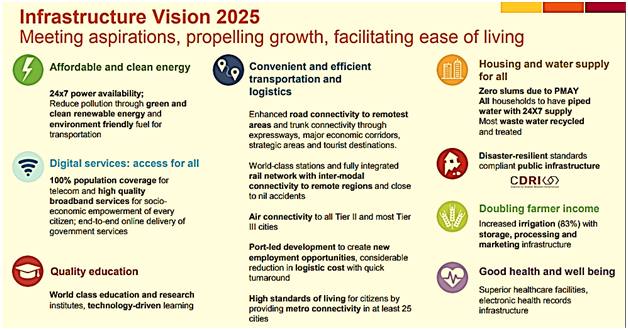Introduction
The National Infrastructure Pipeline (NIP) dashboard would allow monitoring of all the infrastructure projects under the 111 trillion rupees National infrastructure pipeline (NIP). NIP dashboard will be a digital platform to ensure data and updated information for investments across various sectors. All the infrastructure projects will be mapped and evaluated by the concerned departments. The Finance ministry will monitor the implementation and actual progress compared to the initial estimates of the NIP for each project. The move assumes significance as focus on infrastructure projects will help revive the economy following the covid-19 crisis.
National Infrastructure Pipeline

- NIP will enable a forward outlook on infrastructure projects which will create jobs, improve ease of living, and provide equitable access to infrastructure for all, thereby making growth more inclusive.
- NIP includes economic and social infrastructure projects.
- It also includes both greenfield and brownfield projects.
- It will help in stepping-up annual infrastructure investment to achieve the Gross Domestic Product (GDP) of $5 trillion by 2024-25.
- The Centre and states are expected to have almost equal share in implementing NIP, while the private sector contribution is expected to be around 21%
Utility of NIP dashboard
- The NIP dashboard will link the national infrastructure pipeline to the India investment grid which manages and monitors investments across various sectors capturing data on Investments from States and Central Government.
- The dashboard would provide real-time information about the projects for prospective investors also letting the people of the country know how many projects are being implemented.
- If any approval stucks somewhere it would be highlighted on the dashboard. This would increase accountability.

Issues of implementation in infrastructure sector
- In Infrastructure development there are several stages: design stage, finance stage, bidding stage, construction stage and operation stage.
- Design stage:
- It involves making blueprint of the projects, finance stage deals with getting funds or investments, bidding is mainly about assigning the projects to suitable companies, and construction and operational stage deals with on ground physical implementations of the projects.
- There are few caveats at each stage, in the design stage, India lags behind countries like China which focus more on the design stage than any other stage to enhance the standards of their infrastructure.
- Finance stage
- To develop projects from ideas on paper, corporate bonds and long term financing is required for the development of the projects.
- Government resources like tax money are not adequate therefore there is a need to raise money capital from the private sector and foreign investments.
- However the borrowed money is to be paid back, announcing freebies like free electricity to get political mileage increases the economic stress on infrastructure.
- Bidding Stage
- Many companies are awarded contracts in corrupt ways through crony capitalism. Many times in the bidding of a project design and past record of the bidder are not properly scrutinised.
- Construction Stage: Due to land acquisition delays and litigation issues, the rate of implementation of projects is very slow on global standards, due to which India is behind than most of the countries in rate of project execution, the NIP dashboard does not address these issues.
- Getting approvals are very difficult in terms of land access, environmental clearances,impending litigation in court delays the infrastructure projects.
- Operational Stage: Lot of foreign investment is available for completed assets for example Delhi and Hyderabad metro, but new projects are not looked at by the foreign investors.
- Thus it is the responsibility of the government to initiate the primary construction which could be done by using Indian rupees.
Way forward
- The data provided on the dashboard should not just provide data on investments for economic analysis, but also be made more actionable by providing information about upcoming projects.
- In infrastructure projects initiated by the government, they could too use private consultants in designing and determining techno-economic feasibility.
- The private sector should also be involved on a collaboration basis with the governments, whether it is a detailed project report or anything it should be done in a partnership mode rather than shifting responsibility. The onus of implementation of the project should be shared.
- Online bidding can be a viable option to bring about transparency in bidding.
- In monetizing the infrastructural assets, National interest infrastructure investment trust could play crucial role
Conclusion
The NIP dashboard is a step in the right direction to provide real time information and data on Infrastructure projects. This would facilitate assimilation of data and information from all the stakeholders like Central and State Governments, Urban Local Bodies, Banks and Financial Institution, PE funds, and private investors, both local and foreign on one platform to increase accountability and transparency in the infrastructure sector.
For more such notes, Articles, News & Views Join our Telegram Channel.
Click the link below to see the details about the UPSC –Civils courses offered by Triumph IAS. https://triumphias.com/pages-all-courses.php


